Cover Story
Exacting Asymmetry of Longwood Reimagined's Glasshouse Keeps the Team on Its Toes
July 17, 2024
Cover Story
Exacting Asymmetry of Longwood Reimagined's Glasshouse Keeps the Team on Its Toes
July 17, 2024The West Conservatory glasshouse is the challenging centerpiece of the $250-million Longwood Reimagined project, the century-old garden’s most ambitious development ever.
Photo courtesy of Longwood Gardens/Bill Hill
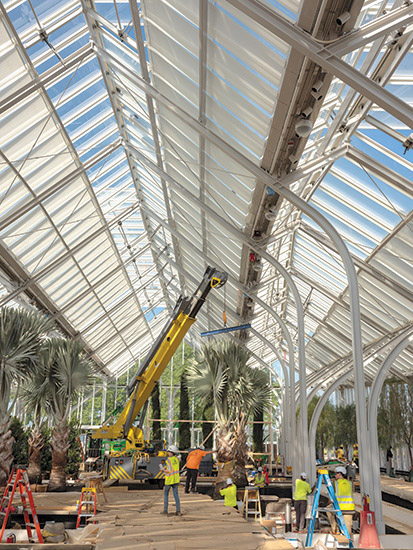
The team is preparing for the garden’s Nov. 22 opening by installing the plantings and commissioning the many building systems.
Photo by Daniel Traub
In 1998, six contractors operating in different regions in the U.S. began gathering every six months to share best practices. Little could anyone predict that a quarter century later, the support group, called PeerCon, would go beyond its original purpose and directly enable the $250-million Longwood Reimagined project—an ambitious redevelopment of 17 acres in the heart of the historic Longwood Gardens, near Wilmington, Del.
Fast forward 20 years to a 2018 PeerCon meeting in Seattle, attended by Greg Sawka, president and CEO of Bancroft Construction Co., an original member of the group and the construction manager for Longwood. While at the meeting, Sawka was in the throes of preconstruction planning for the job back in Kennett Square, Pa. It was, hands down, the firm’s largest and trickiest project.
The biggest nut to crack was the 32,000-sq-ft West Conservatory, an expressed-steel glasshouse, designed by WEISS/MANFREDI Architecture. The icon of Longwood Reimagined, set to open Nov. 22, has a subtly asymmetric pleated roof with doubly curved members, little repetition and tight tolerances.
The project, further complicated by a garden that would be open to the public during construction, has seven main parts indoors and out, including a total of 190,000 sq ft in five different building types that are interconnected via concrete tunnels to a common basement utility plant under the glasshouse.
The sprawling program was so multifaceted that Sawka figured Bancroft needed help. So in Seattle, in a break from PeerCon tradition, he broached the idea of partnering with another original member, GH Phipps Construction Cos.
Two years passed. COVID-19 hit and work slowed a bit for Phipps. Seasoned superintendent Bruce Schneider, with Phipps since 1977, was not only available for an assignment, he was drawn to a career-topping swan song before retirement. And he had botanical garden work experience.
“The stars aligned,” says Sawka. Rather than full-on partnering, Bancroft and Phipps inked a Schneider-on-loan agreement in March 2021, at the start of construction at Longwood.
The agreement “was cutting edge for our peer group,” says Schneider, Longwood’s senior lead superintendent. “I would recommend doing it again to our peer group partners.”
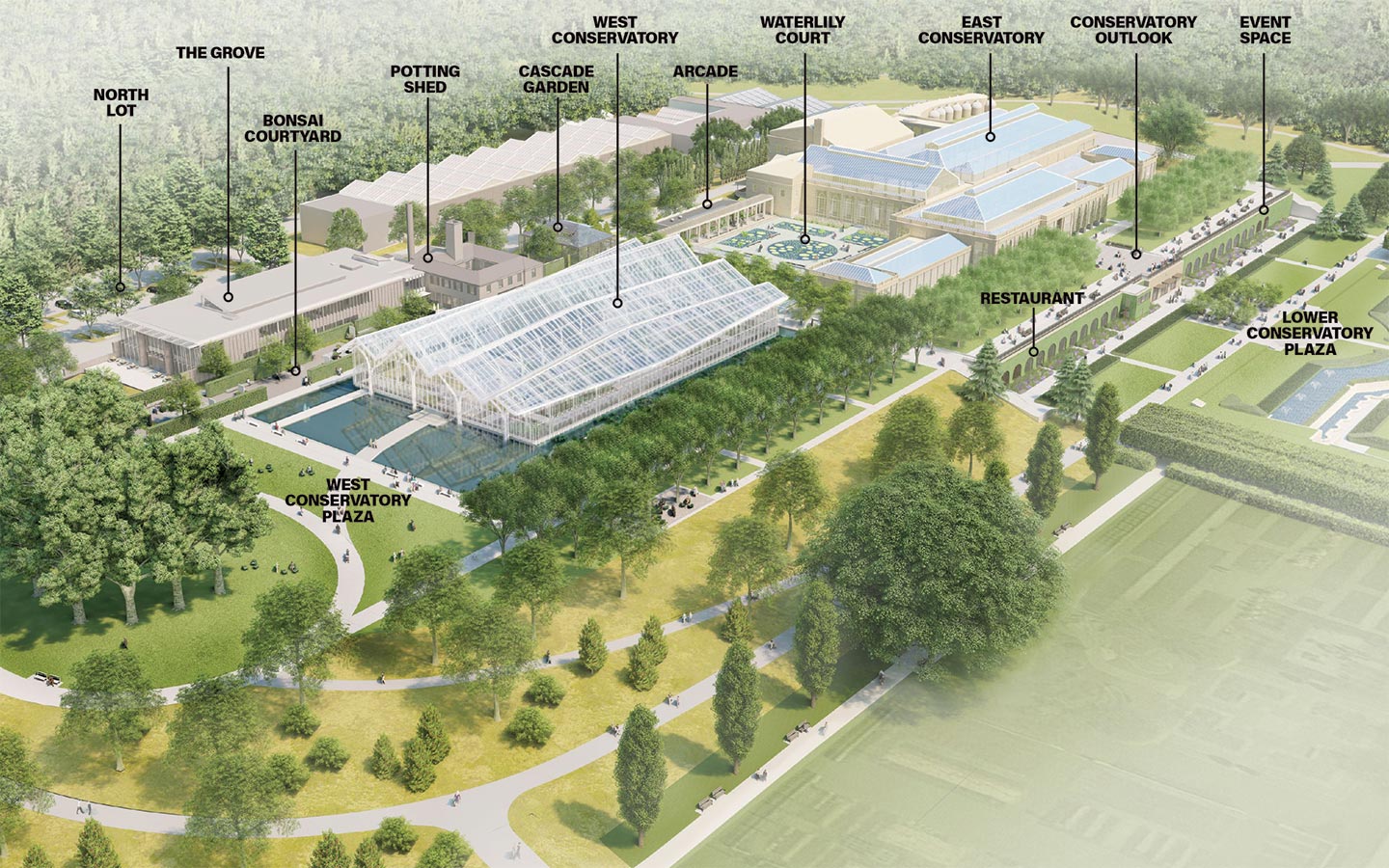
The 17-acre Longwood Reimagined development along the Crystalline Ridge, extends the public parts of the garden to the west of the century-old East Conservatory.
Rendering courtesy of WEISS/MANFREDI with Reed Hilderbrand
Schneider has taken newfound knowledge back to Phipps, both about how to manage a bigger team on a large-scale project and how Bancroft prepares drawings. He was so impressed with the project that soon he suggested his nephew, Mike Guillan, a Phipps 20-year veteran, join him as one of the four project superintendents. Uncle and nephew live in a Longwood Gardens house on campus and walk to work.
Calling the project “challenging and fabulous,” Schneider considers it a “spectacular job” for ending a career. Those sentiments are echoed by more team members, who describe it as inspiring, demanding, unique, collaborative, collegial and a once-in-a-lifetime opportunity.
The West Conservatory is a “piece of art,” says Michael Lopuszanski, a senior project manager with GMI Contractors, which is responsible for building the glasshouse.
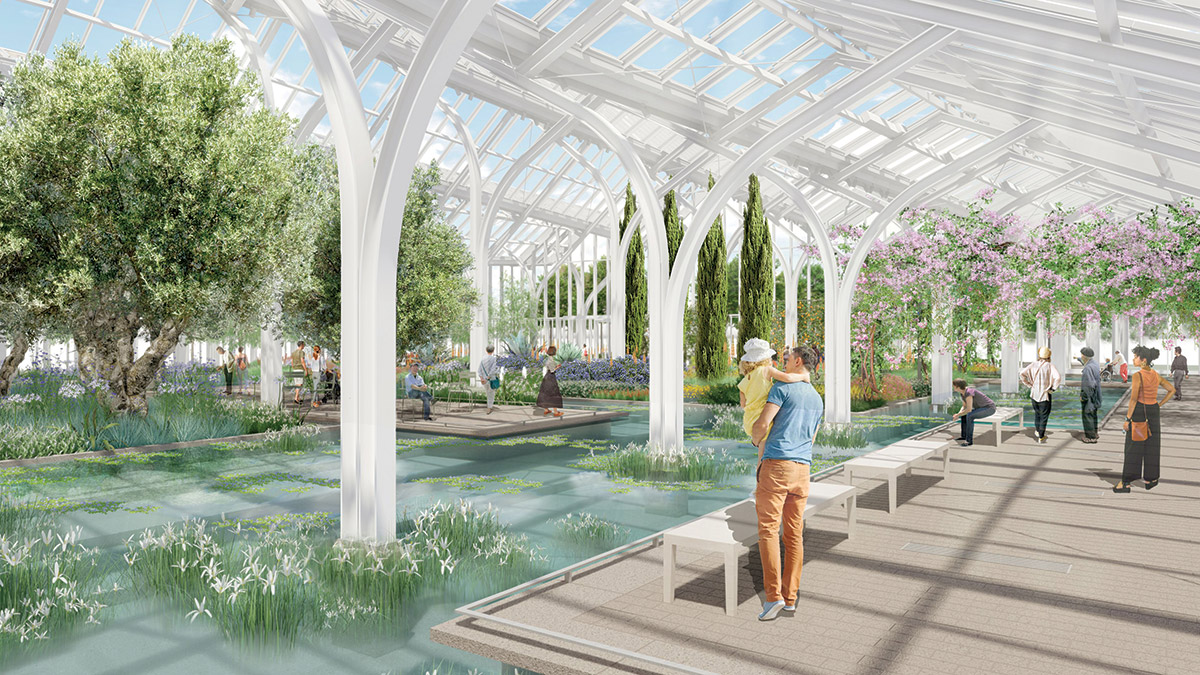
The interior reflecting pools are intended to give the impression the building is floating.
Rendering courtesy of WEISS/MANFREDI with Reed Hilderbrand
Lopuszanski and others can thank Paul B. Redman, the garden’s president and CEO since 2006, for the opportunity to be galvanized. For the mastermind behind Longwood Reimagined, the project is the realization of a vision to “document the past and look to the future” of the 1,100-acre garden, which dates to 1921, and to further delight the garden’s 1.6 million annual visitors.
Redman set the tone for the project as a collaboration of all parties involved, including the garden’s management and horticultural staff and the nearby community.
“The partnership between Longwood and Bancroft is extraordinary, and that’s not always the case in this industry,” says Sawka, who has led Bancroft for 10 years of his 25-year tenure, and has been involved with many of the nearly 50 jobs for Longwood since 2007. “This [project] can be a model for getting things done well,” he maintains.
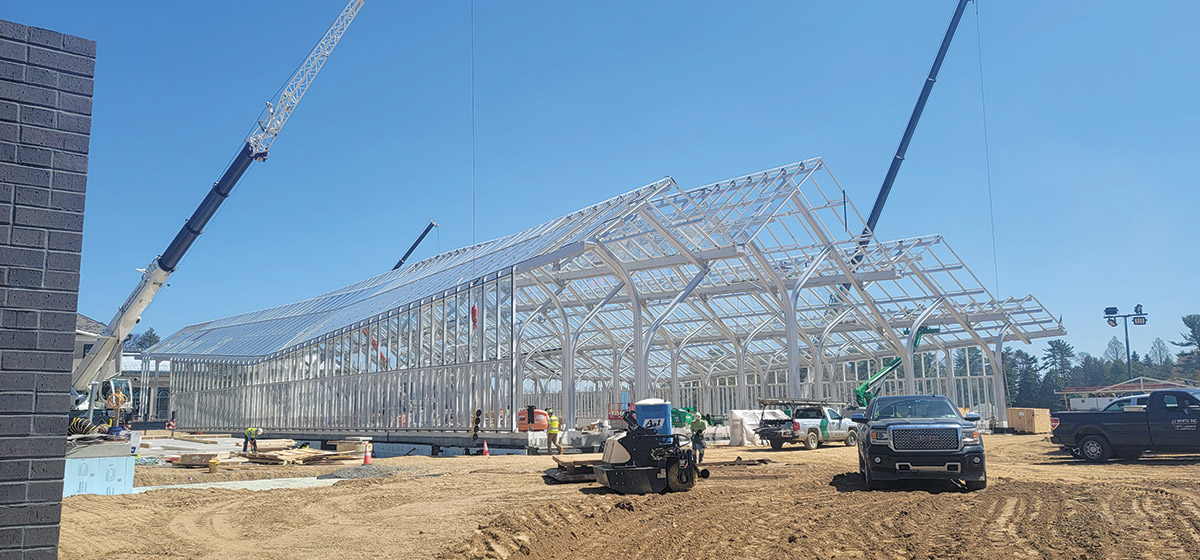
The many curves of the glasshouse were inspired by the curves of the Lord and Burnham greenhouses that formerly occupied the site.
Photo courtesy of GMI Contractors
Sawka was reminded this spring of the relationship with his client. It was a Friday, at about 6 p.m., after a torrential downpour on the East Coast. Sawka was out of town. His phone rang. It was Redman, who rarely called.
“I remember thinking, ‘Uh-oh,’” says Sawka, worried something on the site was awry. Redman quickly assuaged his fears. He had called to say that as he drove by the rear entrance of Longwood after the storm, he had seen a lone Tony Ingram, Bancroft’s senior project manager, shoveling mud off the road. “Paul’s message to me was, ‘We have a good one there, in Tony,’” says Sawka. “I already knew that, but it was good to hear.”
For Longwood Reimagined, which Sawka says is on time and on budget despite schedule workarounds primarily caused by COVID-19 and supply-chain snags, Bancroft serves as construction manager at risk, with a guaranteed maximum price of $226.3 million.
The redevelopment is funded by $200 million from the sale of tax-exempt bonds, $10 million in endowment spending and a $40-million donation from the Longwood Foundation, the private foundation established by the garden’s creator, Pierre S. du Pont, to support the operations of the nonprofit educational institution.
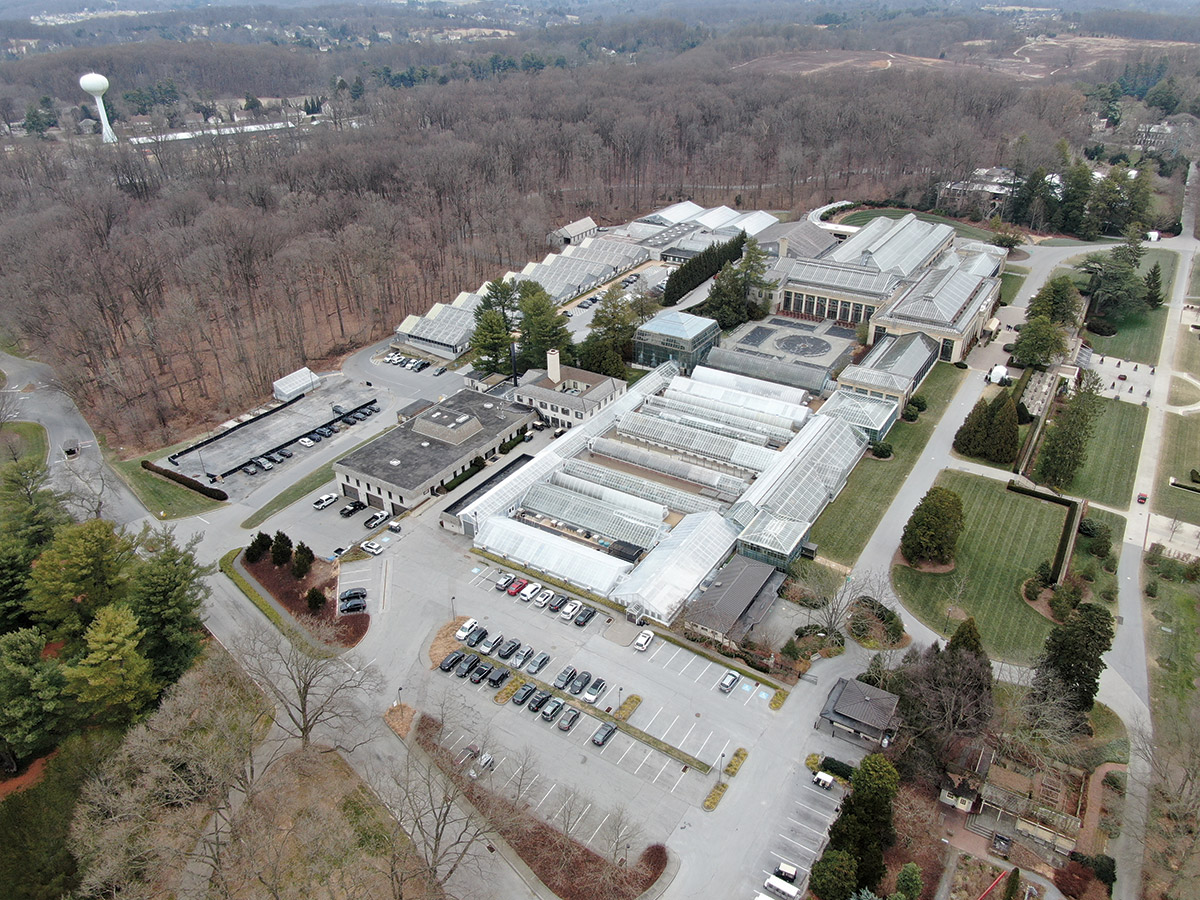
The familiar Lord and Burnham greenhouses and the parking lot adjacent gave up their spots on the ridge for the new West Conservatory.
Photo courtesy of Bancroft Construction
Continuous Improvement Culture
Longwood, Bancroft and the design team began working together on the expansion in 2017. Formal quarterly meetings from 2018 through 2022 helped build “a culture of continuous improvement in our processes, communications and problem-solving,” says Ingram. Informal discussions continue.
Longwood Reimagined, which includes a revamping of visitor circulation, extends the public areas to the west of the century-old East Conservatory along Crystalline Ridge, which overlooks the famed fountains to the south.
The main pieces of the project, except for the field of 128 geothermal wells just to the south, are along the ridge: The glasshouse, with its 232-ft x 141-ft footprint, replaces relocated greenhouses. The petite Cascade Garden is a new 3,800-sq-ft glasshouse that preserves the only extant design in North America by the well-known Brazilian landscape architect Roberto Burle Marx. Other main elements are an education-administration building called the Grove, a new restaurant and event space at the foot of the East Conservatory looking toward the main fountain, an outdoor bonsai tree courtyard and an enhanced Waterlily Court.
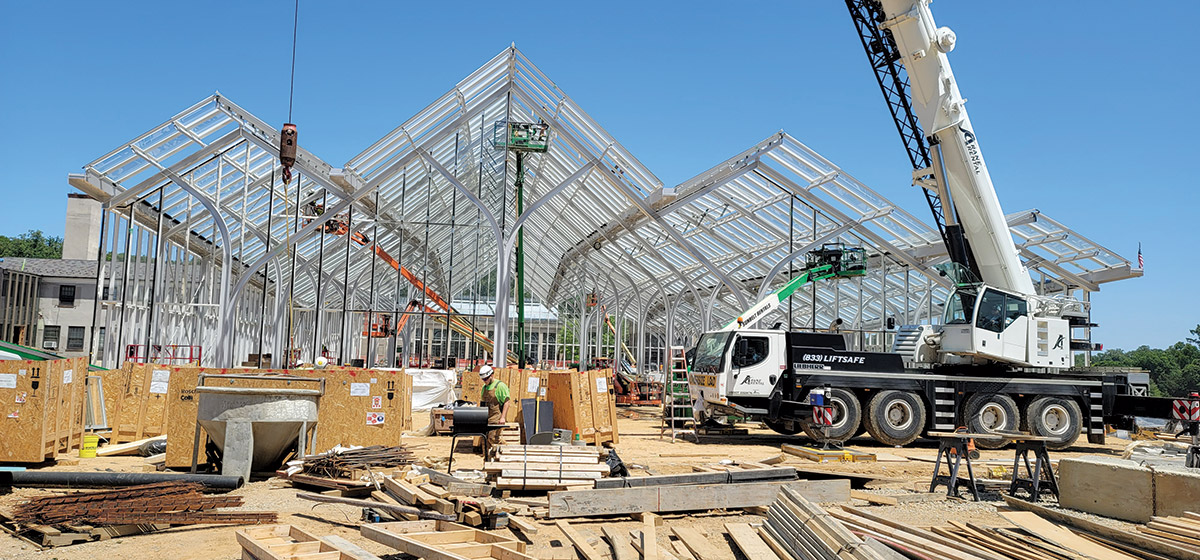
The different-height peaks of the pleated roofline offer the visitor either a feeling of being in a cathedral, under the high peak, or a more intimate experience along the sides.
Photo courtesy of GMI Contractors
For the glasshouse architecture, “we were inspired by the cathedral effect created by Longwood’s groves of trees and the curved geometries of the Lord and Burnham greenhouses that were previously on the site,” says Marion Weiss, a WEISS/MANFREDI partner. The lines of trees in the grove are “continued” into the glasshouse by lines of structural steel tree columns with curved limbs.
WEISS/MANFREDI designed a more-intimate visitor experience along both long sides of the glasshouse, where the gabled roof is lowest, and a more exalted experience through the long midsection, which peaks at 48.5 ft. Five longitudinal roof members, called gutters, curve midway along their length, either in plan, section or both, to create the perspective of an even longer building, says Weiss.
The glasshouse’s “Mediterranean garden celebrates Longwood’s cultivated gardens and wild landscapes,” defined by water, stones and plants, says Kristin Frederickson, a principal with project landscape architect Reed Hilderbrand. To reflect that, the West Conservatory has pools outside and in to create a floating building effect.
The charge to the structural engineer was to size and detail the expressed structure so that it was “barely there,” says Jay Taylor, a retired senior principal of Magnusson Klemencic Associates (MKA). That was not easy to do, for “it was not always immediately obvious how to translate the architecture into a structural solution,” he adds.
Taylor knew an off-the-shelf solution wouldn’t work. For inspiration, he drew upon two earlier MKA projects in Seattle with highly integrated and expressed steel-and-glass structures: the Amazon Spheres and the Olympic Sculpture Park Pavilion.
MKA spent from April 2018, when the concept was set, to December 2019 finessing the details, working with the design-assist, turnkey glasshouse supplier, Roschmann Steel and Glass Construction, in Germany. “It takes a lot of work to make it look simple,” Taylor says.
To support the glazed roof, the frame has 13 lines of moment-frame tree columns in the short direction, and secondary steel in the long direction, bearing on a one-level reinforced concrete basement. Trunks are made from two wide-flange (WF) members, one for each limb. At different heights, the trunk WFs split into two asymmetric curved outstretched limbs, typically connected at their tips.
Conceptual graphic courtesy of MKA
*Click the image for greater detail
Constant Radius
WEISS/MANFREDI established a constant radius for the curved limbs but each tree reads differently because limb spring points differ, which makes the heights of the trunks different, explains Taylor.
Hollow structural tubes, called purlins, and the curved built-up-plate gutters span longitudinally between the frames to support a custom glass roof and brace the trees. Tension rods, in the form of Xs, brace the frames laterally.

The layout and alignment of each tree column and its roof steel were critical to ensure the giant skylight’s operable windows would sit snugly on top.
Photo courtesy of GMI Contractors
The building is symmetric about the center transverse axis, at frame line seven of the 13, but there is no axis of symmetry in the longitudinal direction. That complicated steel erection, says GMI’s Lopuszanski.
Purlin-to-frame and gutter-to-frame connections have intentional openings for conduit. This allowed the conduit to sit atop the steel members—invisible from the ground, as desired by the architect. “It is quite rare for a structural connection to be designed and detailed based on electrical conduit sizes,” says Hannah Bonotto, an MKA associate.
For the glasshouse’s infrastructure, WEISS/MANFREDI specified passive and natural systems for heating, cooling and ventilation to minimize operational carbon emissions. Glasshouses are “intrinsically unsustainable,” says Michael Manfredi, a WEISS/MANFREDI partner.
Even without a garden under glass, “determining a microclimate for both visitors and plantings is difficult,” says Scott Frank, co-managing partner of the mechanical-electrical-plumbing engineer, Jaros Baum & Bolles. For this, JB&B formed a partnership with Atelier Ten, which developed the building’s energy model. They used the model to design basic attributes of the MEP systems, rather than simply to demonstrate code compliance, which was unusual in 2017.
Using the model to simulate natural ventilation scenarios, the team was able to select tolerable conditions for the plantings and the visitors. The result is “a design that will significantly improve environmental and energy performance over a conventional approach,” says Frank.
Nico Kienzl, founding director of Atelier Ten’s New York City office, says the “passive strategies have to carry the day,” though there is some perimeter heating and fans, especially to minimize fogged-up windows in the winter.
All systems are integrated by building controls. For radiant heating and cooling, there is tubing embedded in the walkways. A horizontal system of buried earth tubes preconditions ventilation air delivered to the walkways, taking advantage of the consistent ground temperature. During extreme weather conditions, supplemental heating and cooling coils in the air-handling units further refine the air temperature.



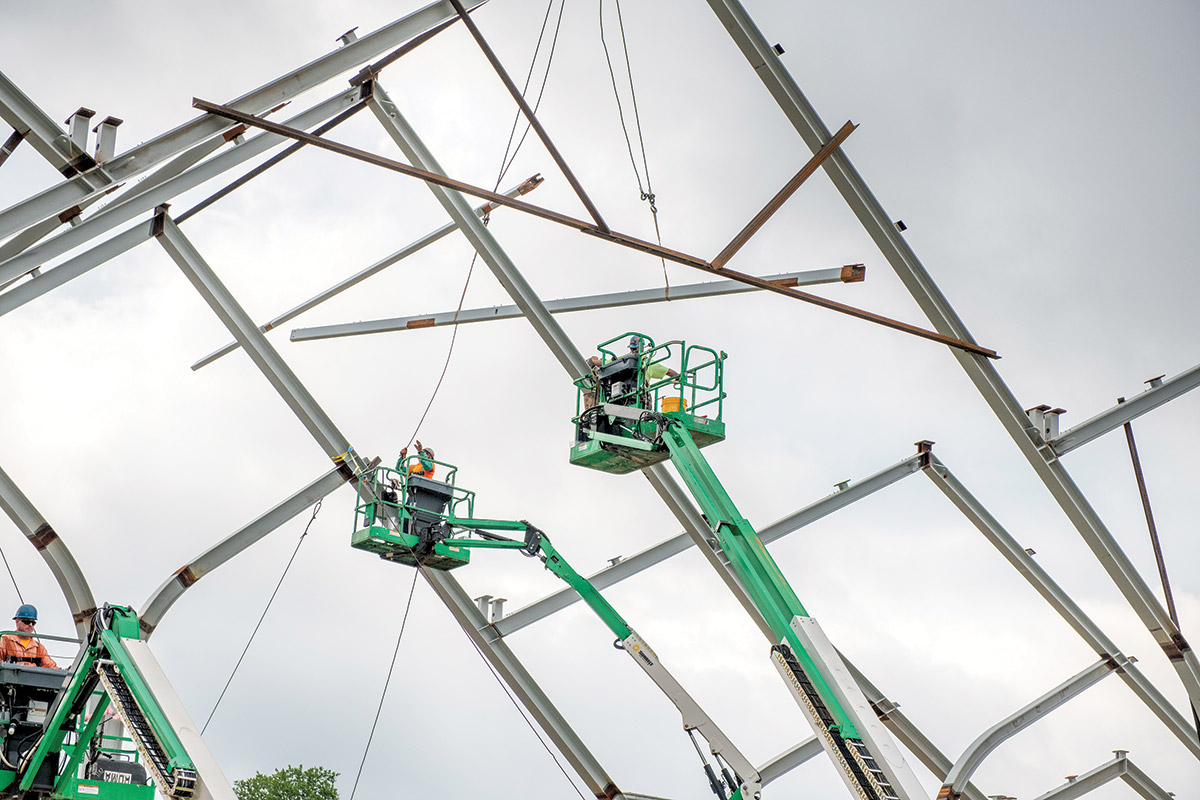
Steel was fabricated in Germany (left), shipped to Longwood and assembled into tree frames on site before being tilted up and craned into place, one sightly different section after another. Little repetition in the frames and layout meant no learning curve for the steel erector.
Photos courtesy of Roschmann Group
Dedicated root-zone heating for plantings, which includes hydronic tubing, maintains targeted temperatures.
A geothermal energy system and water-to-water electric heat pumps provide hot and chilled water. In the winter, heat is extracted from the ground via geowells to provide low-temperature hot water for heating. Conversely, in the summer, cooling is achieved by transferring heat from the buildings to the ground.
For natural ventilation, the facade has automatic operable windows, positioned both near the ground and near the roof peaks. A steam-pipe snowmelt system is integrated into the structure and the window mullions.
Bancroft sequenced the work to balance the needs of garden operations and visitors. Although the projects had different start dates, they overlapped. West Conservatory prep work came first in March 2021. Demolition of the old Grove was delayed until necessary for the West Conservatory excavation. Work then began on the restaurant and event space, followed by the new Cascade Garden and the Waterlily Court.
Challenges were many from the start, including a surprise of having to replace the main steam feed to the existing conservatory before beginning the big glasshouse. The team fast-tracked the replacement.
The elevated finish work, such as installing conduit and other piping on the big glasshouse roof members, was difficult because it was executed from lifts at elevations 20 ft to 50 ft above the slab. Bancroft sequenced the overhead work to begin as soon as crews finished the installation of a bay of steel and glass, wanting to clear the slab for waterproofing. “This required planning for how many lifts could be working in each structural bay and the sequencing of trades working east to west behind the glass and steel,” says Bancroft’s Ingram.
Once complete, the lifts were removed and other tasks began atop the structural slab, including the waterproofing and installation of the precast walkways outlining the interior pools, 4 ft above the structural slab. Crews then did final overhead tasks from lifts on the walkways, in preparation for the interior landscaping.
Even the 17 acres of sitework—which includes six gardens with pavers, drains and more plus extensive landscaping around the buildings—was not simple to coordinate. The landscaping’s schedule, logistics and impacts on building access were factored into all planning discussions and required closer than typical coordination between the interior and exterior trades, says Ingram. Collocation of trade partners helped facilitate this, he adds.
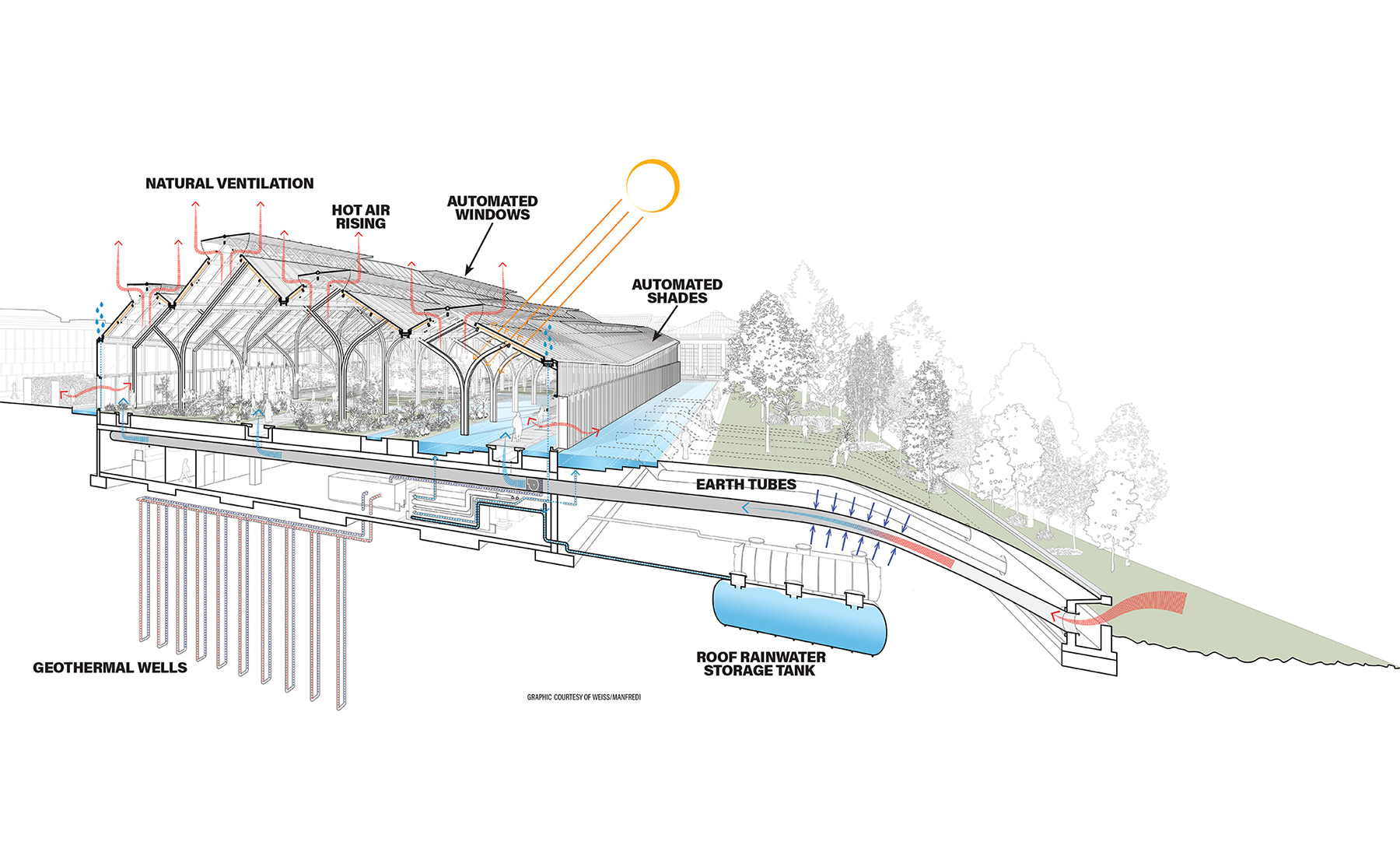
Graphic courtesy of WEISS/MANFREDI
A big hiccup involved a delivery delay for electrical switch gear—ordered based on the advertised 56-week lead time. The Bancroft team was able to work with its trade partners and suppliers directly to cut the supplier’s revised 86-week delivery estimate by about 15 weeks. Permanent power was available in time for critical equipment start-ups, including chillers and air-handling units. That in turn allowed finish work to begin.
In a major fluke, the garden and the project team had to shut down for four days, beginning last Sept. 4, because an escaped convict was hiding in the area. Bancroft and Longwood were able to coordinate with local and national law enforcement to access the site for critical watering needed for the newly planted landscapes.
A bigger problem was that the chiller startup was scheduled for the week of the shutdown. In anticipation, the supplier’s representative was in from out of town. To allow the startup to occur as scheduled and avoid a two-month delay, the police provided an escort into the site for a small team.
The West Conservatory was the most complicated job. For starters, “it was a huge effort to fabricate,” says Marco Bürner, project manager for Roschmann, which has a $27.1-million turnkey contract for the building.
The war between Russia and Ukraine complicated both the fabrication and shipping of the glass, which was manufactured near the Russian border. Out of safety concerns, the design team did not visit the plant. They had to settle for virtual meetings.
One of many challenges in fabrication was that each of the roughly 1,400 roof panes is unique, says Bürner. Two visual mock-ups and one performance mock-up, all in Germany, helped work out the glazing system. Bürner says it would have been better to do the performance mock-up at a test facility in York, Pa., to be closer to the building team.
Steel fabrication was also challenging, especially because of the curved members. One problem concerned the connections of the curved-to-straight WF members.
“The steel profile was bending so much that it got out of shape,” says Bürner, adding that the team had been alerted to the possibility but was “surprised it happened to such an extent and at each connection.”
MKA’s Bonotto explains, “As you curve a member, there is a dimension change.” The WF elongates on one side, which goes into tension, and compresses on the other.
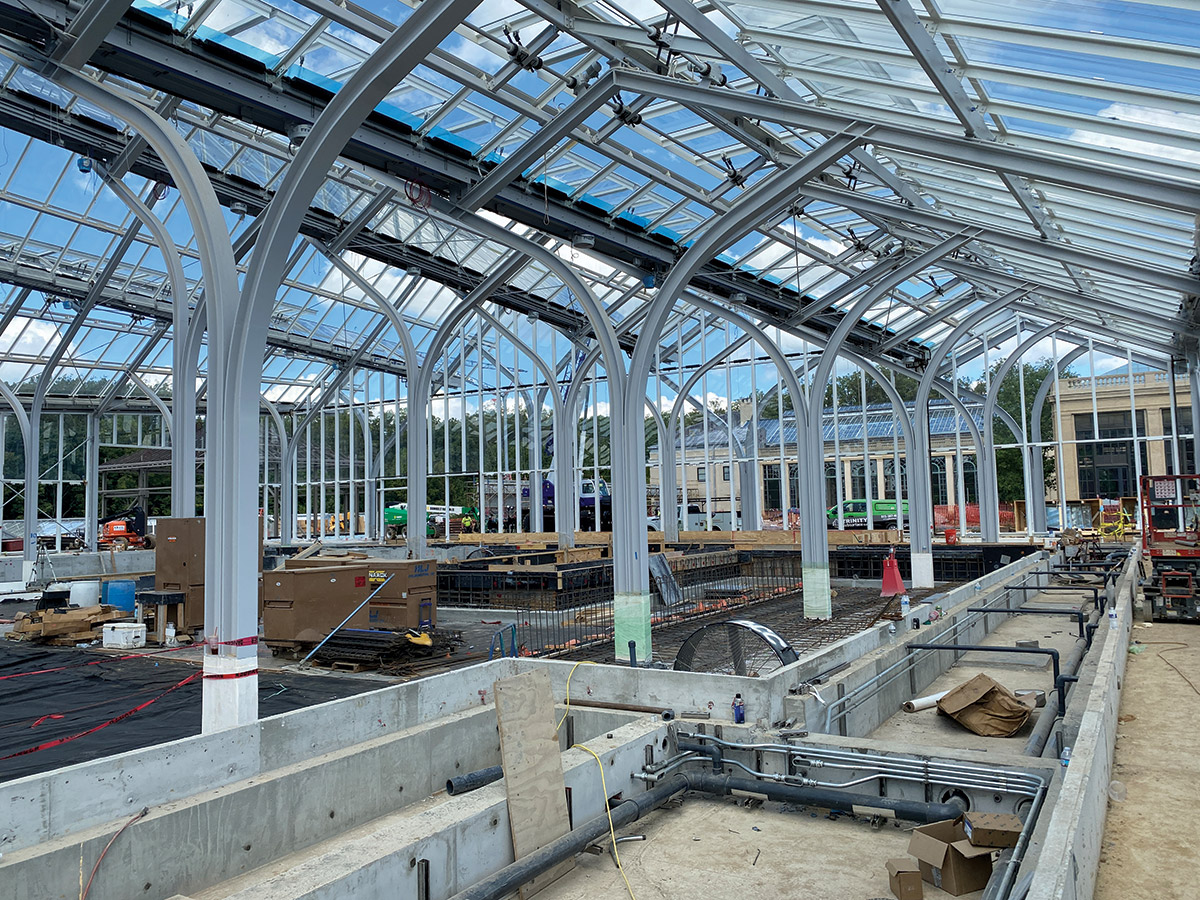
Waterproofing of the structural slab, which holds pools of water, irrigation systems and more, was critical to protect the central utility plant in the basement below.
Photo courtesy of Roschmann Group
Bonotto and other members of the building team made a trip to the fabricator’s plant in Germany to help figure out a workaround. The solution was to cut notches into the ends of the bent members and then fill them with weld steel. That way, the curved member ends would match the straight members. The filled notches were then ground so they were flush with the straight member and not at all noticeable on the expressed steel structure.
Shipping congestion during COVID plagued steel deliveries. No containers were available, the harbors were jammed and there was a huge queue, says Bürner.
One workaround was to use roll-on, roll-off flatbeds rather than containers. Another was to switch ports. “We switched ports so many times, on both ends, and used three ports in Europe and almost each port on the East Coast,” says Bürner.
Work at Longwood was also challenging. There was almost no learning curve during erection because there was little repetition, says GMI’s Lopuszanski, a sub to Roschmann. Each column line was different because the trees are not laid out in a regular grid. Field welding ruled, which is always tricky. And the thousands of pieces had to meet up perfectly to 1/16 in., he adds.
The glasshouse would have been impossible to execute without teamwork; total station surveying again and again of each piece during assembly and installation; and a digital twin for piece-by-piece location in the puzzle. “We built this using a 3D model more so than from the drawings,” Lopuszanski says.
The erection of the structural steel was done in a modified stick-built fashion. In preparation, ironworkers would weld an assembly, typically including one tree with its gable, on laser-leveled steel tables at waist height, before tilting up the assembly and setting it in place, using a crane.
Ironworkers typically erected the north-south moment frames in four sections. The intention was to move east to west, but the curved steel in the center did not arrive on time, so the erector, Roma Steel, jumped to the west side. There were concerns about the meet-up but the midsection members “just dropped right in,” says Lopuszanski.
The erection was sequenced to start at the column line on the north side, farthest from the crane to the south, which had a four-column reach. That allowed other crews to work “without being near the crane,” says Steve Hardeski, general foreman for Roma Steel. The next column line began at the south and moved north, again from north to south and so on.
Guys and other temporary steel stabilized the frames and kept the trees plumb until secondary steel locked everything together and made the structure self supporting. “There was as lot of field welding,” says Hardeski.
The high peak did not have its own tree. “We had to marry the gable” to both trees already installed in the line, says Hardeski. To fit in the high-peak section, ironworkers had to use clamps, wedges and connecting bars, he adds.
The steel work started in late June 2022 and topping out was at the end of that October, pretty much as scheduled, says Lopuszanski.
Currently, finish work, including planting, filling the pools and commissioning all the systems, is under way or starting soon. “We’re on the home stretch,” says Longwood’s Redman. The transformation is not intended as a model for other U. S. gardens, he adds, but “if others are inspired to stretch or reach, that would be wonderful.”








_ENRready.jpg?height=200&t=1737051881&width=200)
